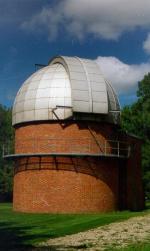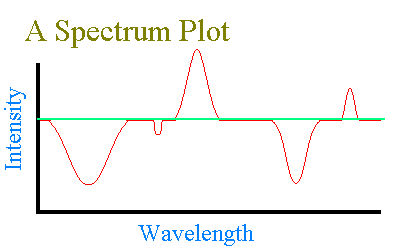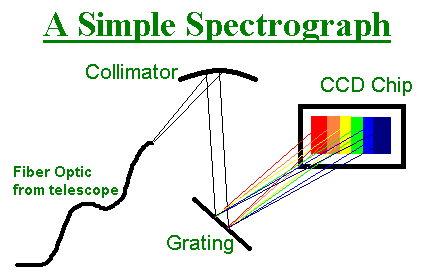| Warner and Swasey Observatory |
| Case Western Reserve University | Nassau Station |
| Visitors |
|
» Home » News » Gallery » Reference » Weather |
| Science Resources |
|
» NSRT User Interface » Software » Data Archive » Download Data |

|
 |
About Spectra
What is a Spectrum?
Have you ever noticed that if you pass white light through a specially shaped piece of glass that you can break it up into all the colors of the rainbow? This "rainbow" is a spectrum of visible light. ("Spectra" is the plural of the word "spectrum.") Visible light comes in a range of wavelengths with different energies and our eye distinguishes these as colors. The glass (usually a prism) causes different wavelengths of light to take slightly different paths, splitting them up into a spectrum.
Light should be thought of as energy emitted from a material. By studying light energy we can learn about the material and the conditions the material is under.
What are the types of spectra?
Spectra come in three flavors: continuous, absorption, and emission.

Continuous Spectra
If you look at the spectrum from a common incandescent light bulb, you'll see a relatively smooth spectrum with no part being brighter or darker than any other part. This type of a spectrum is called a continuous spectrum.
The filament in the light bulb is essentially heated by the electricity passing through it to a temperature of about 4000 degrees. The atoms in the filament get excited and start to wiggle around, producing light energy in a coherent continuous distribution that we see as a featureless continuous spectrum. Since the spectrum from the light bulb is dependent entirely on the temperature of the filament, this type of continuous spectrum is known as a black body spectrum.
Absorption Spectra
If you look at the spectrum of sunlight, at first it may appear to be a continuous spectrum. If you magnify the Sun's spectrum enough and look at it closely you will see little dark lines that break up the smooth spectrum. These are absorption lines from "cool" gas (cool is several thousand degrees in this case) in the Sun's surface atmosphere. What we see as the surface of the sun essentially emits light as a black body continuous spectrum and then that light passes through a layer of gas that absorbs some very specific wavelengths of light.
But why are only specific wavelengths absorbed? The answer lies in the way that the electrons in atoms behave. Electrons in an atom can jump between discreet energy levels by absorbing or emitting a photon (packet of light energy). So certain atoms under certain conditions will absorb very specific wavelengths of light dependent on the configuration of their electrons. The pattern of absorption lines in a spectrum will be unique to a chemical element so we can use absorption lines to detect the presence of specific elements in astronomical objects.
Absorption spectra are found to come from primarily planets, stars, and galaxies.
Emission Spectra
If you look at a neon sign or candle flame with a prism, you will probably see an emission spectrum. An emission spectrum is almost the reverse of an absorption spectrum. In an emission spectrum, you will see just a few sharp lines of color.
An emission spectrum is the type of spectrum we get from a hot gas. The gas becomes excited and the electrons in the atoms emit photons at very specific wavelengths, in the opposite process to what happens in an absorption spectrum. If you were to put the emission spectrum of an element next to the absorption spectrum of the same element you would find that all of the emission lines and absorption lines match up exactly. As with the absorption spectrum, the pattern of lines is unique to each chemical element and can be used to identify those elements.
Emission spectra are common in nebula, comets, flare stars, and anywhere else you might find excited gas.
Composite Spectra
Sometimes you get more than one type of spectrum occurring simultaneously in the same spectrum. Lines for some chemical elements may be in emission, while others for another element may be in absorption. It is even possible for a line to have both emission and absorption features. The differences tell you about the different conditions each element is under and possibly different transparent layers that you are observing light from. A spectrum with many different features occurring under diverse conditions is called a composite spectrum.
Plotting spectra on a graph
When we analyze spectrum it is almost always easier to do so if we plot the spectrum as a graph of wavelength versus intensity. The colors of light we see are a result of the wavelength of the light changing. For example, red light is a longer (bigger) wavelength light than blue light. So in our illustrations of different types of spectra at the top of this page, the spectra go from red to blue, which is decreasing in wavelength from left to right. Normally in a plot left to right is blue to red since this means then that the wavelength increases on the x-axis from left to right like on most graphs. The intensity is how much light we measure at a given wavelength. Below is an example:

The Continuum
Notice that the absorption lines appear as dips in the spectrum and emission lines are peaks in the spectrum. The green line drawn across is to mark the continuum of the spectrum. The continuum is the intesity of light that would be at that wavelength in the spectrum if the lines were not present. One of the toughest parts of analyzing spectra can be deciding where the continua should be drawn. When there are not a lot of lines, it is easy to see where the continuum should be drawn. But when you increase the number of lines and they start to overlap, it becomes much more difficult to do.
The Lines
The lines in the spectrum are not boxed shaped notches where light is blocked out but instead show a gradual change in intesity of light. The reason for this is difficult to explain in simple terms, but it is due to quantum mechanics (the physics that governs electrons and light). Not all the lines absorb or emit the same amount of light so they are varying depths and heights above and below the continuum. The curve of the line is reffered to as the line profile and the maximum height above or below the continuum is called the line's depth. The profiles and depths of each line tell us how that line was formed and the conditions of the environment it was formed in.
How to we observe the spectra of astronomical objects?
It is not practical to take our prism and hold it up to the sky to observe the spectrum of astronomical objects. There is an instrument called a spectrograph which takes light from the telescope and converts it into a spectrum that is recorded as an electronic image.

The spectrograph for the Nassau Station Robotic Telescope will take light from the telescope and use a fiber optic cable to carry that light to a room under the telescope where the spectrograph will be laid out on an optical bench. First the light exits the fiber cable and is reflected off a collimator. The collimator is a mirror which parrellizes the diverging beam from the telescope. Next the light beam bounces off a grating. The grating is a finely etched mirrored surface which has the effect of breaking the light up into a spectrum. The spectrum is then projected onto a CCD chip which turns the image into an electronic stream of data.
What do we learn from spectra?
So what good is it to collect spectra from astronomical objects? A spectrum can tell us a lot about the composition and properties of the object which the light is coming from including:
- Chemical composition
- Temperature and pressure
- Radial velocity
- Rotational velocity
The most detailed information we can obtain about the physical properties of astronomical objects is through spectra. For an example of the type of projects that professional astronomers do with spectra you can check out John Martin's Ph.D. Thesis web page.